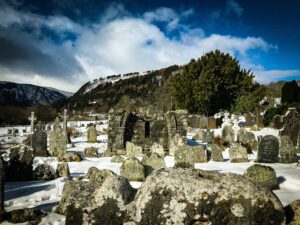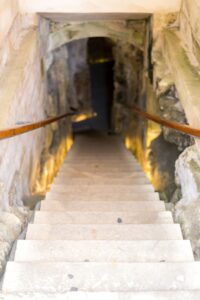The Rolling Stones
According to the most popular Bible translations, Mary Magdalene and the other Mary arrived at Christ’s tomb and found the stone protecting the entrance to the tomb mysteriously had been “rolled away.” Most of the tombs in ancient Jerusalem had huge stones blocking the opening of the tomb in order to close it off from the outside world.
The tomb was protected by these blocking stones for ritualistic reasons but also for practical purposes to keep wild animals out of the tombs.
It has been a tradition to believe the stone that was in front of the opening to the cave was “rolled back” from the entrance. However, most ancient caves did not have their entrances protected by round stones – but by square ones.
Archaeology suggests that the best translation of the original Greek word “kulio” which has been translated “rolled” might also be translated “moved, or “pulled back”.
The Rolling Stone Entrance to Ancient Tombs

Photo by Casper Pedersen on Unsplash
The rolling stones protected the entrance to ancient tombs throughout Jerusalem. These stones came in two general shapes – round and rectangular. More than 98% of the tombs built during the first century were protected with a square stone.
The author of this report indicates that of the more than 900 burial caves evaluated for their blocking stones from this period, only four are known to have been protected by a round stone.
Jerusalem has rich limestone deposits which can be hollowed out and serve as a temporary repository of the dead.
The entrances to these tombs were generally rectangular like a modern door, and would easily be protected by a rectangular stone.
Two kinds of recesses built into the limestone to serve as repositories for the bodies;
- Loculi (or “kochim” in Hebrew) which are deep recesses about six feet deep and 18 inches wide, and
- Shallow cavities called “arcosolia” if the top of the niche is arched, and “quadrosolia” if the top of the recess is straight.
About a year after the original burial, the family revisited the tomb after the body had decomposed, and collected the bones to be reburied in a bone storage box called a stone ossuary.
Rectangular Blocking Stones
Rectangular rolling stones were rather like corks sealing a modern bottle of wine. The closer end fits snugly into the entrance while the outside portion of the stone was supported by other stones.
These stones securely blocked the entrance to the burial area to prevent the desecration of the decaying body.
Round Rolling Stones
The few round rolling stones which have been found are large – about 4 feet in diameter.
They are more often used to cover the entrance of more elaborate tombs of richer people. It should be noted that Christ borrowed the tomb of the rich leader Joseph of

Photo by Karim MANJRA on Unsplash
Arimathea and so it would be consistent with archaeological findings that his tomb might be covered by a circular stone.
The best example of a circular stone comes from the Tomb of Herod’s Family which can be viewed behind the King David’s Hotel in Jerusalem.
Another example is the Tomb of the Kings which is actually the tomb of Queen Helena of Adiabene located just outside of the Old City of Jerusalem.
Both the tomb of King Herod’s Family and that of Queen Helena of Adiabene are elaborate and not the usual tomb of the common person.
There is another elaborate tomb in the Kidron Valley which was sealed by a round stone. The advantage of a round stone is the relative ease by which it could be rolled aside in order to open the tomb in order to place a new body inside or to remove the bones from a decayed corpse for secondary burials.
Interestingly, after the first century AD, round blocking stones seem to have become much more commonly used. Dozens of circular stones have been found from the second to seventh century AD throughout Israel. These stones were somewhat different from the first century rounded stones in that they did not lay on a track for easier removal, and were smaller generally measuring only about three feet in diameter.
Rounded Stones in Scripture
All four of the gospels mention rounded stones used in the burial of Christ, and these stones were referenced as being “rolled” away.
Some have argued “rolling back” this is not the right translation of the Hebrew word and might more accurately be translated as “moved away.” This view is supported by the fact that the angel who moved the stone away from the entrance of the tomb is then referred to as sitting on the stone. It would obviously be much easier to sit on a rectangular stone than on a rounded one.
The Tomb of Christ
The gospels hint that the tomb itself was rather small. This is because the interior of the tomb could be viewed from the entrance. Most early histories suggest that Jesus’ tomb had an entrance corridor, and there were burial niches on either side of the corridor.
It also seems doubtful that Christ was laid inside a recess within the wall of the tomb as was the custom of most burial sites. This is because the gospels indicate that the two angels were “sitting where the body of Jesus had lain, one at the head and the other at the feet.” This positioning of the two angels would be difficult were the body laid within a recess.
The Burial of Christ
 Christ was buried on the eve of the Sabbath – it was necessary that this was done quickly before the sunset on that Good Friday in observance of the Jewish law which forbids letting a corpse not to be buried overnight.
Christ was buried on the eve of the Sabbath – it was necessary that this was done quickly before the sunset on that Good Friday in observance of the Jewish law which forbids letting a corpse not to be buried overnight.
The body was quickly covered with a shroud that was bought by Joseph and probably placed on a burial bench in a small cave. The entrance to the cave was then protected by a rolling stone or other covering.
This size of the burial chamber would be in agreement with Scripture indicating that Mary “bent over to look into the tomb,” and saw the two angels sitting at the head and foot of where Christ’s body had been laid.
Christ was buried on Friday on just before the Sabbath. On the third day, the day after the Sabbath, Mary Magdalene and the other Mary visited the tomb as was the Jewish custom.
It is important to note that this counting of days is in agreement with Jewish customs as well. To this day, for example, circumcision of Jewish boys occurs on the eighth inclusive day. The counting starts on the day of birth, and then seven days late the circumcision occurs. This means that if a boy is born on a Monday, the circumcision occurs on the next Monday.
According to Jewish tradition, the visit to the tomb on the third day is to determine the condition of the corpse,
One should go to the cemetery to check the dead within three days, and not fear that such smacks of pagan practices. There was actually one buried man who was visited after three days and lived for twenty-five more years and had sons, and died afterward.
Summary
It is in the little details that the historicity of the gospels can be established.
There is little doubt in the historicity of Christ himself; this is taken as a fact by most modern historians – even atheistic ones.
Stories that are clearly ancient myths do not have the historical details and minutia descriptions as with the four gospels. The rolling stones blocking the tomb, the description of ancient Jewish traditions, and the description of the most common forms of burial chambers substantiate the truthfulness of the story.




